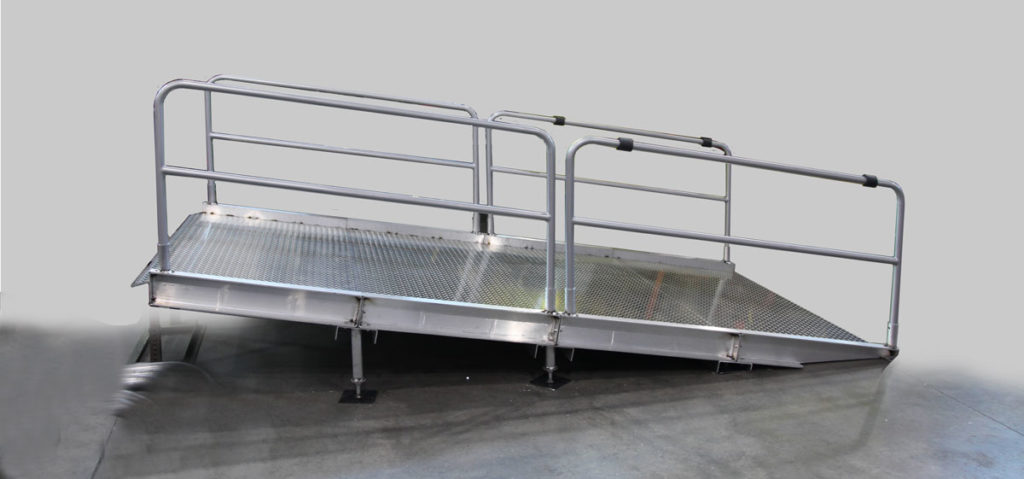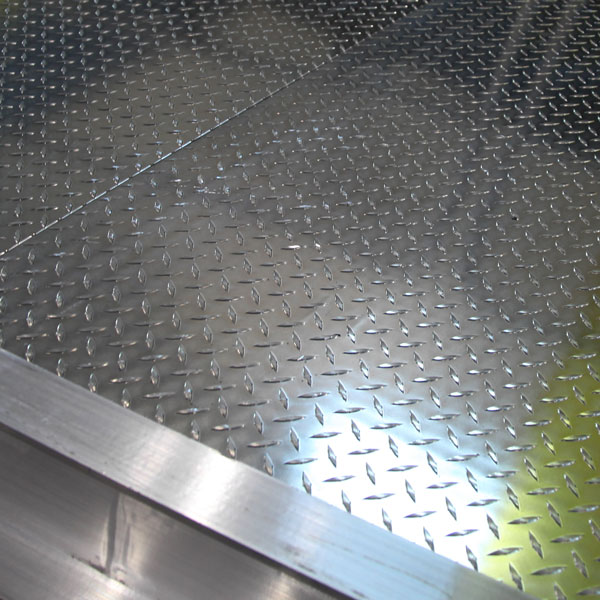
The term, “lightweight material handling ramp,” comes across as very general and all-encompassing. And that is the brilliance of it! There are a plethora of warehouse and/or material handling equipment and vehicles that are used in businesses across the globe. In order for these vehicles/equipment like pallet jacks, motorized carts, stock chases, tuggers, or personnel carriers to function properly, they must have clear and safe passage throughout the location. Sometimes there might be a platform or step or two in the work area that would otherwise render the equipment or vehicle useless. That is where the lightweight material handling ramp comes into play.
The lightweight material handling ramp also maintains the most important part of your business: safety. After all, OSHA exists for a reason. The lightweight material handling ramp adheres to OSHA standards 1910.22(c) and 1926.451(e)(5)(ii) regarding safe access and egress between working surfaces as well as ramp slope. Because productivity and safety work hand in hand, the lightweight material handling ramp ensures that your team stays both safe and efficient.
Now that you know how the lightweight material handling ramp will benefit your business, you’re probably asking yourself, “well, what is it exactly?”
What is a Lightweight Material Handling Ramp?
The Lightweight Material Handling Ramp is a modular ramp that can be configured to different lengths, and thus heights, allowing material handling tools like pallet jacks, motorized carts, tuggers, and other vehicles to load, unload, and transport cargo safely throughout the location whether there be steps, platforms, or other structures present in work areas.
Lightweight material handling ramps require modularity because more often than not they’ll service a wide range of locations and structures. For example, one location may have two steps that have a combined rise of 12” whereas a platform in another location may have a rise of 30”. Because we wanted to create a ramp with the absolute safest incline for use with a variety of material handling equipment and warehouse vehicles, the ramp’s length can vary depending on the rise. The modular construction of the ramp allows for the addition or removal of ramp sections so that the rise and length of the ramp can be easily altered for flexible use across multiple work areas. The legs of the ramp also allow for a few additional inches of adjustability in order to perfectly fit your needs.
What is the Maximum Slope of a Ramp Used for Work?
According to OSHA regulations, 1926.451(e)(5)(ii) the maximum incline for a ramp or walkway is 20 degrees. This requirement effectively sets the standard for the maximum slope of forklift ramps, even though some are designed to serve steeper inclines. We think 20 degrees is much too steep for many other applications, like when using a motorized pallet jack or other warehouse equipment since they are intended for use on mostly flat surfaces.
Our safety recommendation sets the maximum material handling ramp slope of 5.7% degrees (10% grade) which calculates to a ratio of 10’ of ramp for every 1’ of rise. Using this maximum incline, 36 inches (3 feet) of rise would require a 30’ material handling ramp.
We base this recommendation on our experience using the lightweight material handling ramp and our corporate-wide goal of zero lost hours to work-site accidents. (We are, after all, the Stop the Slip company!). Needless to say, safety must be your primary concern and the use of any ramp must take into consideration the unique conditions in your workplace.
What Are the Limitations of the Lightweight Material Handling Ramp?
If your goal is to use a motorized pallet jack or other material handling equipment to move cargo from the ground to a raised platform, there are really only two significant limitations.
First, the lightweight material handling ramp cannot bear the same load as a yard ramp or other portable ramp designed for a forklift. As an example, our lightweight material handling ramp has a 3,000 lb. capacity, which is often more than enough for a motorized pallet jack or other warehouse vehicles. Second, the maximum safe slope means that the ramp could be up to 45’ or 50’, if you intend to use the ramp to reach a surface with a very high rise.

What is the Best Lightweight Material Handling Ramp?
Well, we’re so glad you asked! Industrial Toolz is the originator of the versatile lightweight material handling ramp and you can learn more about our ramp here. Our ramp is unique to the industry, boasting the following features:
ITz’s Lightweight Material Handling Ramp Features:
- Constructed of hard-wearing aluminum with steel legs
- Gradual slope for safe usage with a variety of material handling tools
- 5-ft sections
- 3,000 lb capacity
- Non-slip diamond pattern surface for excellent traction
- Guardrails for added safety
- Optional handrails
- Modular construction, making it easy to install and store
If you have any questions about pallet jack ramps, feel free to give us a call or complete the form below. We’d be glad to answer any questions you might have.